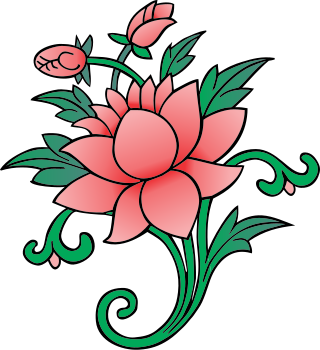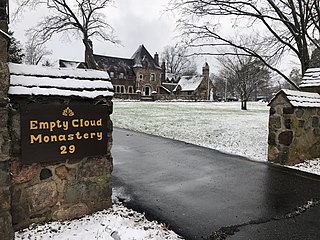
Sangha is a Pali word used in many Indian languages,including Sanskrit which means "association","assembly","company" or "community";in these languages,sangha is frequently used as a surname. In a political context,it was historically used to denote a governing assembly in a republic or a kingdom,and for a long time,it has been used by religious associations,including Buddhists,Jains and Sikhs. Given this history,some Buddhists have stated that the tradition of the sangha represents humanity's oldest surviving democratic institution.

A bhikkhu is an ordained male in Buddhist monasticism. Male,and female monastics (bhikkhunī),are members of the Sangha.
In Chan and Zen Buddhism,dharma transmission is a custom in which a person is established as a "successor in an unbroken lineage of teachers and disciples,a spiritual 'bloodline' (kechimyaku) theoretically traced back to the Buddha himself." The dharma lineage reflects the importance of family-structures in ancient China,and forms a symbolic and ritual recreation of this system for the monastical "family".

The term American Buddhism can be used to describe all Buddhist groups within the United States,including Asian-American Buddhists born into the faith,who comprise the largest percentage of Buddhists in the country.

Upāsaka (masculine) or Upāsikā (feminine) are from the Sanskrit and Pāli words for "attendant". This is the title of followers of Buddhism who are not monks,nuns,or novice monastics in a Buddhist order,and who undertake certain vows. In modern times they have a connotation of dedicated piety that is best suggested by terms such as "lay devotee" or "devout lay follower".

Buddhist monasticism is one of the earliest surviving forms of organized monasticism and one of the fundamental institutions of Buddhism. Monks and nuns,called bhikkhu and bhikkhuni,are responsible for the preservation and dissemination of the Buddha's teaching and the guidance of Buddhist lay people. Three surviving traditions of monastic discipline (Vinaya),govern modern monastic life in different regional traditions:Theravada,Dharmaguptaka,and Mulasarvastivada.
The Pratimokṣa is a list of rules governing the behaviour of Buddhist monastics. Prati means "towards" and mokṣa means "liberation" from cyclic existence (saṃsāra).
The Order of Interbeing is an international Buddhist community of monks,nuns and laypeople in the Plum Village Tradition founded between 1964 and 1966 by Vietnamese Buddhist monk Thích Nhất Hạnh.

A sāmaṇera,is a novice male monk in a Buddhist context. A female novice nun is in Pali:sāmaṇerī,and in Sanskrit:śrāmaṇerī or śrāmaṇerikā. In Tibetan Buddhism,a female novice nun is known by the Tibetan language term getsulma,and a male novice monk is a getsul.
The SīladharāOrder is a Theravada Buddhist female monastic order established by Ajahn Sumedho at Chithurst Buddhist Monastery,England. Its members are known as Sīladharās.

Women in Buddhism is a topic that can be approached from varied perspectives including those of theology,history,anthropology,and feminism. Topical interests include the theological status of women,the treatment of women in Buddhist societies at home and in public,the history of women in Buddhism,and a comparison of the experiences of women across different forms of Buddhism. As in other religions,the experiences of Buddhist women have varied considerably.

The Bodhisattva Precepts are a set of ethical trainings (śīla) used in Mahāyāna Buddhism to advance a practitioner along the path to becoming a bodhisattva. These sets of "restrains" (saṃvāra) are the main ethical code in Mahāyāna Buddhism and as thus also sometimes called "Mahāyāna precepts".
The Taego Order or Taego-jong is the second largest order in Korean Seon,the Korean branch of Chan Buddhism.
Zen master is a somewhat vague English term that arose in the first half of the 20th century,sometimes used to refer to an individual who teaches Zen Buddhist meditation and practices,usually implying longtime study and subsequent authorization to teach and transmit the tradition themselves.
The controversial Eight Garudhammas were considered additional precepts required of bhikkhunis above and beyond the monastic rule that applied to monks. They are controversial because they attempt to proscribe an inferior role for nuns,and bhikkhunis have revealed scholarly evidence that the Eight Garudhammas are not found in the historical teachings of Gautama Buddha.

A bhikkhunī is a Buddhist nun,fully ordained female in Buddhist monasticism. Bhikkhunīs live by the Vinaya,a set of either 311 Theravada,348 Dharmaguptaka,or 364 Mulasarvastivada school rules. Until recently,the lineages of female monastics only remained in Mahayana Buddhism and thus were prevalent in countries such as China,Korea,Taiwan,Japan,and Vietnam,while a few women have taken the full monastic vows in the Theravada and Vajrayana schools. The official lineage of Tibetan Buddhist bhikkhunīs recommenced on 23 June 2022 in Bhutan when 144 nuns,most of them Bhutanese,were fully ordained.

Blue Cliff Monastery is an 80-acre (0.32 km2) Thiền Buddhist monastery located in Pine Bush,New York. It was founded in May 2007 by monastic and lay practitioners from the Plum Village Tradition.
Zen was introduced in the United States at the end of the 19th century by Japanese teachers who went to America to serve groups of Japanese immigrants and become acquainted with the American culture. After World War II,interest from non-Asian Americans grew rapidly. This resulted in the commencement of an indigenous American Zen tradition which also influences the larger western (Zen) world.

In Buddhism,the abbot is the head of a Buddhist monastery or large Buddhist temple. In Buddhist nunneries,the nun who holds the equivalent position is known as the abbess.

Empty Cloud Monastery is a gender-inclusive,non-sectarian Buddhist monastery in West Orange,New Jersey,United States. It was co-founded by monks AyyāSomāand Bhante Suddhāso through their non-profit,Buddhist Insights. Originally rooted in New York City,the monastery acquired a historic property,previously a Catholic monastery,to provide a communal space where residents of all genders,both monastic and lay practitioners,engage in traditional Buddhist practices while maintaining separate living arrangements. Open to the public,the monastery hosts free retreats,residencies,and events featuring guest monastic teachers from diverse Buddhist traditions. Their daily routine includes chanting,meditation,work,study,and personal practice.










